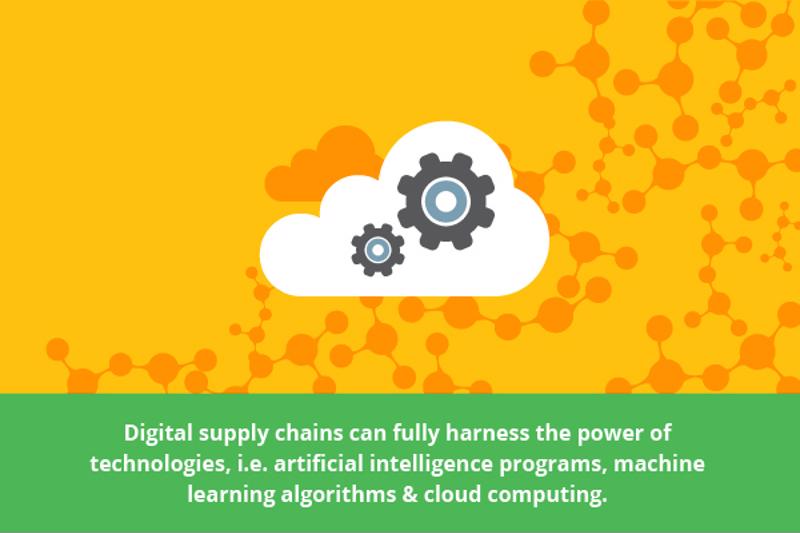When music CDs were first released in the 1980s, “digital audio” was one of the key points in the marketing of their advantages over then-dominant cassette tapes and vinyl LPs. The upshot was that CDs could deliver more information at a much higher quality than those analog formats. Digital supply chains have a similar edge over their predecessors – they can more efficiently capture and distribute data to their stakeholders.
More specifically, they can fully harness the power of technologies such as artificial intelligence programs, machine learning algorithms and cloud computing. This helps them achieve far greater scale and efficiency than traditional supply chains, which are both highly siloed and heavily dependent on legacy IT infrastructure.
Tapping into the advantages of the digital approach requires understanding its accompanying terminology, which can at first seem overwhelming and even confusing. We’ve put together a glossary to make things easier (you can also check our our digital transformation page to learn more). Let’s get right into it:
Artificial Intelligence
Better known as just AI, artificial intelligence is the work performed by intelligent agents such as computer programs, which are aware of their operating environments and function autonomously within them to achieve desired goals. AI might involve the collection and interpretation of data for applications including computer vision and digital assistants in a supply chain. It can be “strong,” with the ability to adapt to unfamiliar situations or “weak,” with its uses limited to narrowly defined cases.
Augmented Reality
AR is the overlaying of digital information onto the real world. Many smartphones are already equipped for AR, while even traditional TVs often display AR enhancements like yellow first down markers in American football games. For supply chains, AR offers many potential uses, including special glasses that display overlaid and optimized paths through a warehouse, thereby streamlining the pick-and-pack process.

Blockchain Technology
Although it’s closely associated with cryptocurrencies, blockchain has many non-monetary uses, especially in digital supply chain management. It is essentially a different take on the database, one in which data is housed in blocks that are time-stamped and cryptographically linked so as to prevent subsequent modification. The immutability of blockchains can make them useful for settling payments and other transactions throughout a supply chain, since stakeholders can trust that blockchain data hasn’t been tampered with.
Cloud ERP
An ERP system helps keep supply chains efficient and organized, serving as an interconnected hub for key applications such as procurement, planning and accounting. Cloud ERP solutions from vendors like Oracle go a step further by making ERP functionality much more scalable and flexible, as well as easier to manage. With a cloud ERP, customers have access to a straightforward upgrade process, better integration between applications and tons of pre-built features such as dashboards and embedded AI.
Intelligent Automation
This blanket term covers multiple technologies and processes for automating manual tasks. It can include back-office automation that makes it easier to store and access documents, advanced optical character recognition for quickly recognizing typed and handwritten text, robotic process automation (see below) and more.
Internet of Things
The IoT is the network of billions of non-traditional computing devices, most notably embedded sensors. These devices are typically connected via IP networks like the public internet, allowing them to send and receive data from servers. Through the IoT, organizations have access to improved asset tracking via GPS and RFID, which provide more granular information than barcodes and tracking numbers. They can also take advantage of IoT robots that can scan QR codes and receive information wirelessly for purposes including tracking and predictive maintenance scheduling.
Machine Learning
Similar to AI, machine learning involves intelligent agents like software applications acting autonomously, often in ways that resemble human intelligence. The main difference between the two is that machine learning doesn’t require the agent to be explicitly programmed to perform a specific task – it can learn on its own. In supply chains, machine learning is well-suited to discovering insights within large sets of data and applying them to the improvement of demand modeling, forecasting and shipper networks.
Managed Services
In the context of a supply chain, managed services are a natural complement to solutions like cloud ERP apps. Both managed services and cloud computing support continuous improvement, meaning that the benefits of digital supply chain transformation aren’t limited to the stability and security of the initial setup. A managed services provider can help oversee the selection of the right solutions and also assist with the technical implementation and maintenance.
Platform-as-a-Service
One of the three most basic forms of cloud computing along with Software-as-a-Service and Infrastructure-as-a-Service, PaaS encompasses a full cloud-based environment for developing, deploying, maintaining and updating apps. PaaS simplifies these processes by including tools such as business intelligence capabilities and various types of middleware, which sit on top of cloud infrastructure such as servers and secure network connections. Maintaining a digital supply chain along with critical systems of record like cloud ERP is more straightforward with PaaS in place, compared with the traditional approach of working with older on-premises technologies.
Robotic Process Automation
RPA is the use of machine learning and AI to automate what is often called “swivel chair work,” i.e. the manual entry of the same or similar data across multiple systems. Think copying and pasting entries between spreadsheets or portals. The robots in questions are software agents that can work like a human within a graphical user interface to complete those tasks, plus many others like running jobs in an ERP or sending automatic replies to emails.
As integrated supply chain experts, the Inspirage team can help you turn the concepts in this glossary into reality. Learn more by visiting our resource center or contacting our team directly.